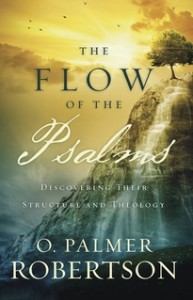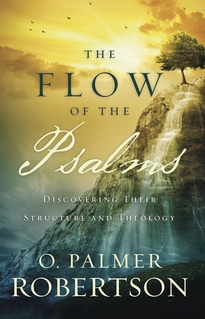Robertson, O. Palmer, The Flow of the Psalms: Discovering Their Structure and Theology. Phillipsburg, NJ: P&R Publishing, 2015.
 O. Palmer Robertson is the director and principal of African Bible University in Uganda. He previously taught at Reformed, Westminster, Knox, and Covenant seminaries. He has authored such works as The Christ of the Covenants and The Christ of the Prophets.
O. Palmer Robertson is the director and principal of African Bible University in Uganda. He previously taught at Reformed, Westminster, Knox, and Covenant seminaries. He has authored such works as The Christ of the Covenants and The Christ of the Prophets.
The Psalms appear to be a haphazard collection of prayers and praises. Robertson argues, however, that the Psalms showcase a deliberate structure at the hands of their final redactor. Because the Psalms developed over a long period of time, the final redactor selected certain psalms for certain locations (p. 7). By discerning this structure, one may see how the Psalms connect with each other and gain insight into each Psalm (p. 3).
He notes the Psalter divides into five books, each of which ends with a doxology (p. 8). He identifies already extant Psalm collections (p. 10). Next, he observes how the redactor distributed different authors throughout the Psalter. For example, Davidic Psalms dominate Books I and II, but their number diminishes in Books III–V. The redactor also positioned significant Psalms at the literary seams: Psalm 72 by Solomon concludes Book II, and Psalm 90 by Moses begins Book IV. These placements suggest deliberate choice rather than haphazard assembly.
Robertson then identifies the two “poetic pillars” which introduce the Psalms: Psalms 1 and 2. These two Psalms—a Torah Psalm and a Messianic Psalm respectively—summarize the main themes of the Psalter: God’s law and God’s king/Messiah. According to Robertson, a Torah Psalm appears with a Messianic Psalm three times in the Psalter; each time at a pivotal point (p. 16).
Next, he discusses minor structural markers: the placement of the acrostic Psalms (p. 16), the groupings celebrating the kingship of Yahweh and His Messiah (pp. 16–17), the Psalms of Ascents (p. 17), Psalms of Historical Recollection (p. 18), Focal Messianic Psalms (pp. 18–19), Psalms Confessing Sin (p. 19), “Poetic Pyramid” Psalms (p. 19), and the Hallelu-YAH Psalms (p. 20). He devotes less space to these markers in the beginning of the book, although he handles them in more detail during his exegesis. Robertson concludes this overview, stating, “Taken together, these various groupings just listed account for a large segment of the Psalter. Other groupings or interconnections bind the entire book of Psalms into a well-organized composition (p. 21).”
In the following chapter, Robertson considers the redemptive historical framework of the Psalms. He applies his work from The Christ of the Covenants to the structure of the Psalms. He emphasizes the role of the Davidic covenant in the Psalms, although themes from prior covenants appear as well. He presents the macro-structure of the Psalms in chapter 4. In the remainder of the work he explains the structure of the Psalter Psalm by Psalm.
Robertson argues convincingly for a deliberate structure and flow for the Psalms. Through his exegesis, he delineates how the Psalms connect on a macro and micro level and how these connections communicate the Psalter’s message.
One connection comes in Book I. Robertson observes that Psalms 3–17 show the Messiah’s (David’s) struggle to overcome his enemies and establish his throne. Psalm 18 is a turning point. The superscription indicates that David wrote this Psalm after he had been delivered from the hand of Saul. However, previous Psalms (e.g., Psa 3) depict events after Saul’s death. Robertson thus observes the redactor’s hand. The redactor considered thematic and theological factors above temporal or historical factors when he arranged these Psalms, showing the establishment of Messiah’s throne through mortal combat with his enemies. Although conflict continues to reign, the tone of Book I changes after Psalm 18. The king must still fight, but he now enjoys a modicum of stability (p. 78). Significantly, this change in tone occurs at the second Torah/Messiah Psalm pairs.
Also, Robertson demonstrates a connection between the themes of Books I and II. The focus changes from the king’s conflict with God’s enemies to his communication with them. Robertson shows that the Psalmist, though still engaged in conflict, now addresses the nations. For example, Psalm 67 uses Elohim when it cites the Aaronic benediction (p. 113). Such an address does not appear in Book I. Since the Psalmist now addresses the nations, he uses Elohim instead of YHWH. Robertson shows that Book I consistently uses YHWH while Book II uses Elohim. Old Testament scholars have noted that the biblical authors frequently use Elohim when they intend their message for non-Israelites. These lines of evidence strengthen Robertson’s overall argument.
Robertson makes a strong connection between Books III and IV. At the end of Book III, the Davidic covenant and monarchy have apparently failed. Since the Davidic covenant plays such an important role in the Psalms, the Davidic failure casts a pall over YHWH’s promises. In this context, Robertson observes that Book IV begins with the only Psalm of Moses. This Psalm returns to the beginning of Israel’s history and YHWH’s rule then, before a king ruled in Israel. This Psalm proceeds to the “YHWH Reigns” collection. Robertson again sees the redactor’s hand. The redactor placed these Psalms in this order to show that YHWH has always been Israel’s king, whether the Davidic king proved faithful or not (p. 147). Through this placement, the redactor shows that Israel’s faith has matured. Robertson’s observation illuminates both the location of Moses’s Psalm and the purpose of the “YHWH Reigns” collection.
Robertson bolsters his case by appealing to the New Testament’s use of the Psalter. The New Testament authors quote certain Psalms more than others, and Robertson observes that the most popular Psalms appear at key junctures within the Psalter. For example, Psalm 110 and Psalm 118 bring the Messianic focus to a climax in the Psalter, and New Testament authors quote these Psalms, along with Psalm 2, more than any other Psalm (p. 195). Psalm 118 also appears in the final Torah/Messiah Psalm pair. While not all will accept Robertson’s appeal to the New Testament for verification, he has illumined the surrounding context of every Psalm quotation in the New Testament through his study of the structure. Those who study the use of the Psalms in the New Testament should find a reliable foundation for their work in Robertson’s study.
Although Robertson interacts with different Psalms scholars, he maintains a theological and pastoral focus throughout the book. He argues that one can memorize a large portion of the Psalter by understanding the overall structure and flow (pp. 81–82). Throughout the book, he derives various lessons about prayer from the Psalms. These pastoral insights make this study useful beyond the academy.
The Flow of the Psalms will serve well as an overview of the Psalter. Its contents will initiate Old Testament students into the interpretation of the Psalter. Its pastoral insights will help pastors preaching through or counseling from the Psalms. Educated laypeople will find this book helpful and edifying.
Matthew R. Miller
The Southern Baptist Theological Seminary, Louisville, KY




